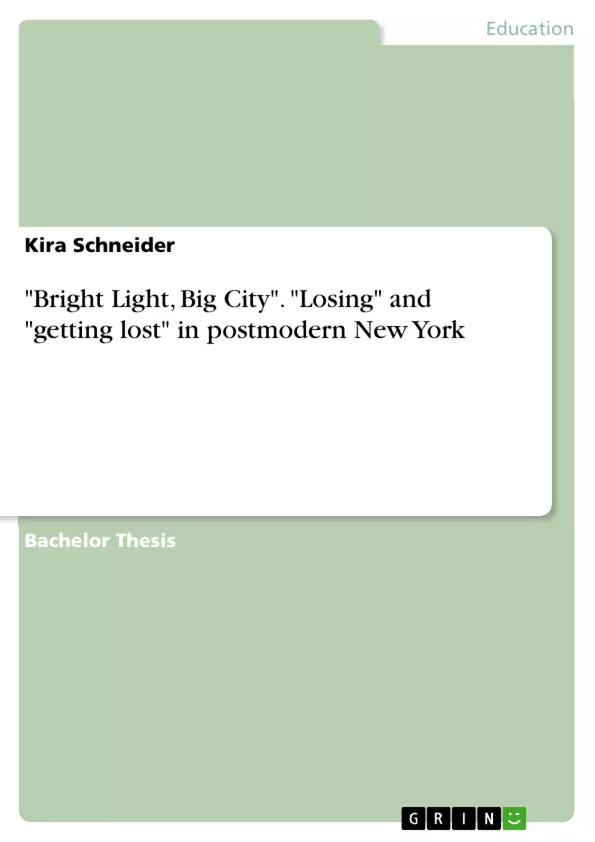The success of his debut novel "Bright Lights, Big City" brought Jay McInerney an astonishing amount of media coverage and an equivalent in book sales, but not much approval, let alone deeper analysis of his work, from critics and scholars. In fact, the hype that surrounded him and his fellow “brat-pack” writers is likely to have prevented any serious scholarly interest in this kind of new urban literature back in the day. “Bright Lights, Big City” was dismissed as a “yuppie bildungsroman- full of tortured self- searching and struggling- writer romance” (Young/Caveney 1992: 47) at first, without any considerable novelty or value. However, the enthusiasm of the large, young readership showed that there was something to McInerney’s novel that other novels did not offer- a setting and a language that were familiar and uncomplicated for them, but, at the same time, an account of relevant, postmodern issues that very well did concern the Bright Young Things of the 80s, but were usually seized in more elitist literature, and thus, eluded an audience that was ready for them to be taken up.
This thesis attempts to perform a detailed analysis, starting with a brief description of the historical and cultural features of the setting and then proceeding to the interpretation of all important themes, motifs and symbols of the book in the context of postmodernism but also in general terms. Each chapter investigates the influence of a certain aspect of the protagonist’s life on his crisis, especially in how far one or the other led him to a life on the edge and to the loss of the self. In order to understand why, in the end, the protagonist has to “learn everything all over again” (BLBC 174) to get back on the right track, it is essential to point out the roles that Amanda- his opportunist model wife- his job in the fact checking department and the death of his mother played over time, and how drugs and Ray-Ban sunglasses seem to provide temporary solutions for the most acute of his troubles.
Inhaltsverzeichnis (Table of Contents)
- Introduction
- 80s life in the US - The setting
- Elite vs. mass culture
- New York and its residents
- Clubs & drug culture
- Amanda and hyperreality
- Reality between fact and fiction
- Postmodern tensions between fact and fiction
- The flight into fiction
- The de-centered subject
- "standing outside yourself"
- Mother-son-relationship
- Conclusion
Zielsetzung und Themenschwerpunkte (Objectives and Key Themes)
This thesis aims to provide a comprehensive analysis of Jay McInerney's debut novel, Bright Lights, Big City, focusing on its portrayal of postmodern anxieties and the protagonist's journey of self-discovery in the urban landscape of 1980s New York. The analysis will consider the novel's setting, characters, and thematic elements within the broader context of postmodernism, exploring the interplay between fact and fiction, the decentered subject, and the impact of consumerism and drug culture on individual identity.
- The impact of postmodernism on urban life and individual identity
- The tension between fact and fiction in a hyperreal world
- The fragmented and decentered subject in a consumerist society
- The role of drugs and nightlife in escaping reality
- The influence of mass culture and media on individual experience
Zusammenfassung der Kapitel (Chapter Summaries)
- Introduction: This chapter introduces the novel, its context, and the critical reception it received. It highlights the novel's relevance for understanding the anxieties and experiences of a generation grappling with postmodern themes in a rapidly changing urban environment.
- 80s life in the US - The setting: This chapter explores the social and cultural landscape of 1980s New York, highlighting the influence of consumerism, drug culture, and the rise of the yuppie generation. It examines the ways in which these factors shaped the protagonist's life and his journey of self-discovery.
Schlüsselwörter (Keywords)
This thesis explores the key themes of postmodernism, urban life, identity, hyperreality, consumerism, drug culture, and the decentered subject in the context of Jay McInerney's Bright Lights, Big City. The analysis draws upon the theoretical frameworks of prominent postmodern thinkers such as Jean Baudrillard, Fredric Jameson, and Jean-François Lyotard to understand the novel's portrayal of these themes and their impact on the protagonist's experience.
- Quote paper
- Kira Schneider (Author), 2014, "Bright Light, Big City". "Losing" and "getting lost" in postmodern New York, Munich, GRIN Verlag, https://www.grin.com/document/342520



